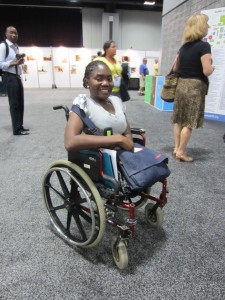Reported from Washington D.C. for Cleveland.com (The Plain Dealer) with accompanying photo slideshow: http://www.cleveland.com/healthfit/index.ssf/2012/07/international_aids_conference_3.html
By Casey Capachi
WASHINGTON, D.C. — When AIDS first started appearing in the early 1980s, it was largely portrayed as an illness that affected only white gay men and intravenous drug users. Women, children, and men of color were largely left out of the first picture painted of AIDS – but no longer.
At the 19th International AIDS Conference, Wednesday’s programming, as well as speakers throughout the week, addressed HIV/AIDS in women and girls.
“As we’ve fought the disease, one of the challenges we have seen is the evolving face of the epidemic,” said U.S. Department of Health and Human Services Secretary Kathleen Sebelius at the conference.
The virus, she noted, affects women in large numbers.
“Globally, AIDS is the leading cause of death for women of reproductive age,” said Sebelius. “Right here in Washington, D.C. black women represent 92 percent of women living with HIV.”
“Only in the US do we think of it [HIV/AIDS] as something that affects only men who have sex with men,” said Tiffany West, who works at the Washington, D.C. Department of Health.

Women make up 21% of women living with HIV/AIDS in Ohio, according to a 2009 Ohio Department of Health report.
Sharon Thomas, 62, an HIV/AIDS advocate from Lakewood, has been living with the disease for 25 years. She said the situation has improved since 1990 when she protested in front of the International AIDS Conference in San Francisco for women to be included in clinical trials. Still, she often worries about the safety of the HIV-positive women she helps.
“We’ve made great progress but the progress that we’re lacking is that women are still abused and live in violent circumstances and told they can’t discuss that [HIV/AIDS],” said Thomas. “That’s still here in the United States.”
According to UNAIDS, 1.3 million women and girls worldwide contracted HIV last year. The majority of those living with the disease are in sub-Saharan Africa.
Former First Lady Laura Bush spoke about the “devastating toll of AIDS” she witnessed on visits to Africa with her husband during and after his presidency. President George W. Bush committed $15 billion over a five-year period (2003-2008) through PEPFAR, or the President’s Emergency Plan for AIDS Relief, to provide treatment and care to those living with HIV/AIDS in the hardest-hit countries.
“The health of women affects families, communities and whole countries,” said Bush after telling the story of a child she met struggling for her life in Botswana, who was born HIV-positive. “Healthy mothers make healthy families.”
Bush was joined by other female public figures in attendance. Among others, Sharon Stone, Hillary Clinton, Whoopi Goldberg, and Nancy Pelosi all took the main stage inside the Washington E. Convention Center to lend their support to ending the HIV/AIDS epidemic.
“Back in the 80s when the epidemic violently exploded, the very first successful information, education, and prevention campaigns in Africa were those led by brave women. Since then women have borne the burden disproportionately,” said Nobel Laureate Françoise Barré-Sinoussi in her first speech as the new International AIDS Society (IAS) President.
“Combating harmful social norms, promoting gender equality, empowering women is essential to boost HIV response in women and girls.”
Follow Plain Dealer reporter Casey Capachi at the International AIDS Conference on Twitter: @caseycapachi